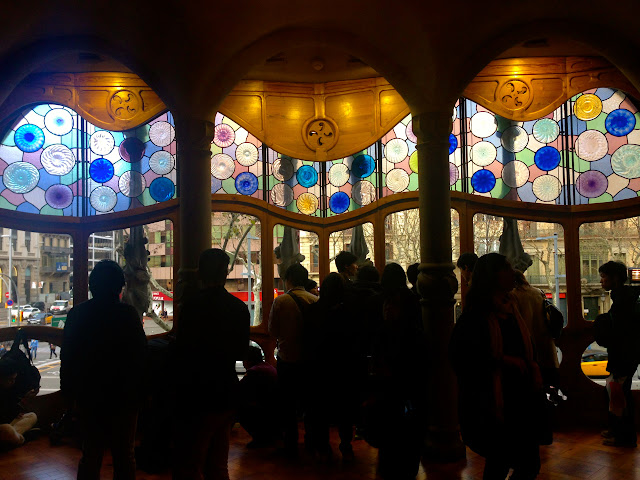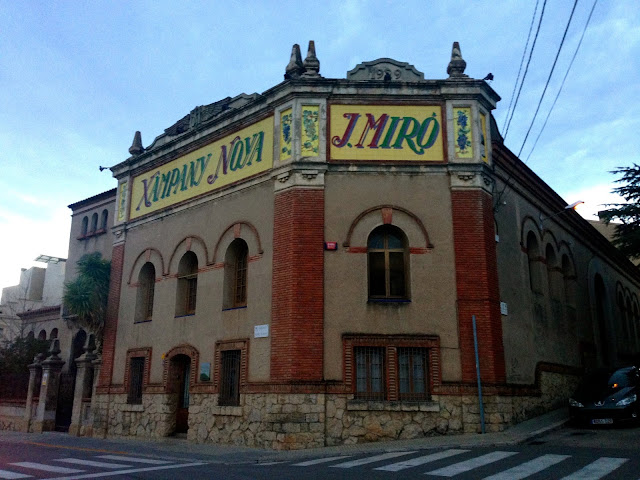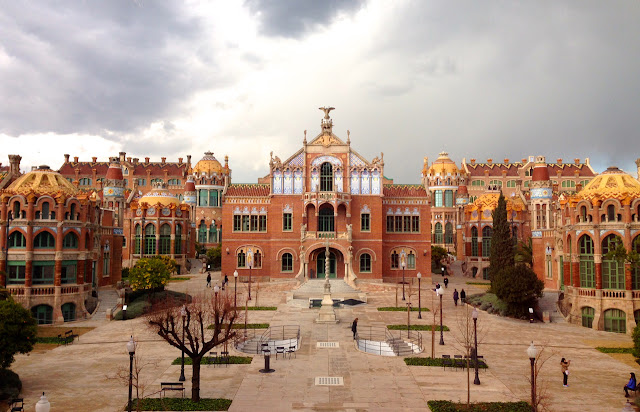Last month, I spent twelve days watching a cat named Arnie in Barcelona. I met his owner, Simon, on the Trusted Housesitters website. A lone cat in a cosmopolitan city is like the Holy Grail of petsitting assignments, so I really lucked out.
The apartment where I stayed was located near the Plaça d'Espanya and the building itself was situated directly over the Hostafrancs metro station. Every 4-5 minutes the gentle rumble of a passing train would cause odds and ends in the house to rattle ever so slightly. It was wonderful.
The shops along the street were a repeated sequence of the butcher, the baker, and the pharmaceutical maker. It was as though there were a city ordinance stating that citizens should never be more than a hundred meters from a blood sausage, baguette, or suppository.
I started my Barcelona adventure at the Museu Nacional d'Art de Catalunya, which was a total steal at only €12 for a two-day ticket. And I definitely needed two days to see everything. You can only look at so many biblical torture scenes before the threat of eternal damnation starts to lose its effect.
While I was there, the museum had a spectacular exhibit on Catalan artist Xavier Gosé, an early 20th century Art Nouveau and Art Deco illustrator and painter. I particularly liked a placard describing the artist's humble beginnings in Paris which read, “Gosé was worn out by the heat in summer and warmed himself in winter by the smoke of cigarettes and the breath of his bohemian friends”.
 |
| Montjuïc Cemetery |
Before heading to England, Simon loaned me his copy of “Weird and Wonderful Barcelona”. The small guidebook mostly made me feel like a geriatric loser for not wanting to go to the suggested underground bars and party until 7am. Those days are behind me. (But they did exist, for anyone who’s questioning my coolness.) Siesta > Fiesta. Anyway, it gave me some very cool recommendations not found on the “Top 20 Attractions” lists I typically read.
For starters, it led me to the Montjuïc Cemetery, which is unquestionably one of the strangest places I’ve ever been. The cemetery was built in the late 19th century to accommodate the population growth caused by Barcelona’s rapid industrialization. According to Wikipedia, it contains more than one million burials and cremation ashes.
When I approached the cemetery, it looked more like a housing complex than a necropolis. The rows and columns of uniform squares seemed to go on ad infinitum. I was impressed at how well the plots were maintained. So many of them had fresh flowers that, based on the engraved dates, could only have been placed by someone born after the occupant's passing.
Human burial rituals are fascinating to me, but also pretty bizarre. I was planning to donate my remains to Bodies: The Exhibition (with the stipulation that they not use my artery clogged heart as an example of a poor diet), but apparently you have to be impoverished and Chinese for them to accept you. Bummer.
As with all my trips, I was on a very tight budget. One way I saved money was by walking everywhere. I also got to see a lot more of the city that way. The metronome of skateboards on cobblestones, wind rushing through bike spokes, and children on scooters provided the soundtrack. I almost got a kink in my neck from staring up, slack-jawed, at all the gorgeous architecture. Every hundred meters or so, I’d stop to take a photo of what I was certain was the most beautiful building in the city.
I have to applaud the waste management system in Barcelona. The city was so clean. Whenever I saw street sweepers late at night, I wanted to salute them. Also, do Barcelonians know how lucky they are to have level sidewalks and ample bike paths? I love Istanbul with all my heart, but it’s definitely lacking in infrastructure. The bumpy sidewalks here are almost completely concealed by cigarette butts, most of them still ablaze.
Granted, every city has its underbelly and I’ve no doubt that there are corners of Barcelona overflowing with trash on uneven pavement. But for the most part, I stayed well within the edges of the tourist map carefully selected by the city’s best cartographers. I could not have been more impressed with what I saw.

On February 14th, Barcelona was my Valentine. We had a fascinating, beautiful, and romantic date. Well, I ended up paying for dinner and haven’t received a response to any of my clever texts, but it was undoubtedly the best Valentine’s Day ever. I visited the Picasso Museum, Gaudí's Casa Batlló, Barcelona Cathedral, and wherever else my lumbering feet lead me.
 |
| Barcelona Cathedral |
During my time in the city, I learned a lot about Catalonia, which for all my fellow know-nothings is an autonomous region in Spain with its own language, culture, and traditions. There's a long and complicated history between Spain and Catalonia with the Catalans often on the losing side. Under the Francoists, their language was banned for much of the 40s and 50s and they were subjected to a slew of other harsh restrictions up until Franco’s death in 1975.
Today, Catalan (a blend of French, Spanish, and some other stuff) is the preferred language in schools. Many exhibits throughout the city had placards with descriptions printed first in bold Catalan, next English, and finally Spanish at the very bottom. I have to think the positioning was deliberate.
Outside of Barcelona Cathedral, I saw a cobla (wind instruments band) playing Catalan music. Several circles of people performed a traditional folk dance called the Sardana, which I later learned was banned under the Franco regime. The participants, who all seemed to be in the 60+ crowd, wore somber expressions as they moved in unison. I didn’t realize the cultural significance of the dance at the time, but the pride these people radiated was almost palpable.
I wonder if forty years from now I’ll be solemnly performing the Macarena in a public square with the rest of my generation. I doubt it. Growing up a white middle-class secular American millennial*, I can’t begin to imagine what it’s like to experience cultural oppression or forced assimilation. It’s heartbreakingly beautiful to me that people can find such immense dignity and contentment through music and movement of the past.
*I am so boring.
 |
| Sweet, sweet Arnie! |
As far as felines go, Arnie is one of the best. We hung out all the time, took siestas on the couch, and he never complained about my Netflix choices. Arnie’s one flaw was that every night around 3AM, he would launch a full assault across my sleeping body.
I don’t mean a gentle nuzzle against my face or a playful paw across my arm, but a blitzkrieg of claws and maniacal meows. At the initial onslaught, I would cocoon myself in the comforter and go limp, like someone being mauled by a bear. Arnie was undeterred. After several minutes of his unyielding attack, I would gently put him outside the bedroom, mumble a friendly "piss off", and close the door. He didn't mind.
Spanish really is a beautiful language to listen to. The conversations I overheard in Barcelona were fast, fluid, and melodic. My nearly nonexistent Spanish speaking abilities, on the other hand, were lethargic, staccato, and monosyllabic.
Because of my background in French, I breezed through a semester of Spanish in university, but in my arrogance retained none of it. So I was stuck with what I’d learned in the 6th grade, which consisted of colors, numbers 1-10, and whatever else was covered in the first VHS tape of Muzzy.
The thing I most remember about middle school Spanish was that our final project was to make a piñata. Throughout the semester, our teacher Señora Gibson encouraged us to get creative. I waited until the last minute to do the assignment and used a single balloon to make an Easter egg. When I turned it in, the newspaper was still wet and the hastily applied pastel paint was streaking down the sides. My wilted egg received a generous B-.
My time in Spain lined up with the Lunar New Year and I felt very nostalgic when I saw a handful of Korean women dressed in traditional hanbok outside of Sagrada Família. When I lived in Seoul, I spent a full week teaching myself how to say “Happy Lunar New Year” in Korean to impress my coworkers. I approached the women in Barcelona and gave a heavily accented, “새해 복 많이 받으세요!”, which was met with oohs and polite applause. It's my proudest moment to date in 2016.
 |
| View from Park Güell |
Set in Barcelona, the 2003 film L’Auberge Espagnole is on the top ten movie list of any American who’s passed French 102. I used to fantasize about living in an Erasmus flat with an eccentric, but lovable amalgam of expats in the heart of a European city just like the main character. I briefly got my wish in Istanbul, but it was actually pretty terrible and nothing like the movie. It turns out that messy roommates and a filthy bathroom are not endearing in real life. (Not even in retrospect.) All the same, I hoped that the film hadn’t missed the mark in its portrayal of Barcelona.
I headed to Park Güell, one of the filming locations, and was not disappointed. I was reminded of the kissing scene and for the first time on my trip got a little lonely. I didn’t necessarily want to have a steamy make out sesh with a sexy Frenchie*, but I wished that there had been someone to take just one flattering photo of me on the colorful bench. And also to give a dirty look to those American exchange students who were clearly laughing at me, I just couldn’t figure out why. Despite approaching several seemingly intimidating and camera-savvy people, I had no such luck on either front. Merde.
*Mais ce serait très agréable.
 |
| Sant Sadurní d'Anoia |
I met up with Duncan, the Editor in Chief of Urban Travel Blog, which is the first (and only) website to publish one of my pieces. A longtime expat in Barcelona, he gave me loads of great tips for exploring the city. For example, he told me to avoid restaurants with photographs of food on the outside, which was good, because I’d been looking exclusively at those eateries.
Duncan kindly invited me to a birthday party in Sant Sadurní d'Anoia, a small municipality an hour’s train journey from Barcelona. This quaint scenic town is the center of cava (Spanish champagne) production in Catalonia. The sunny day was a blur of endless wine, new friends, and onions.
 |
| Grilling Calçots in Sant Sadurní d'Anoia |
My time in Barcelona fortuitously coincided with Calçotada, a Catalan celebration of the harvest of a type of scallion called a calçot. How lucky am I?
After the onions are harvested, they’re grilled over a barbecue. Next, you peel off the charred skin, dip it in a special salsa, tilt your head back, and inhale the scallion like an animal. At least that’s what everyone else was doing, but we were all several cava bottles deep by that point.
 |
| I am a monster. |
The calçots salsa was so good, that when I got back to the city, I bought a jar of it and started putting it on all of my food- sandwiches, pasta, eggs, everything. I'm not sure if it was gastronomically acceptable, but I didn't care. What can I say? I’m a maverick when it comes to sauces.
 |
| Palau de la Música Catalana |
Visiting the exquisite Palau de la Música Catalana was definitely on my itinerary, but it cost a whopping €18 just to visit. Yikes! However, a ticket in the nosebleed section for a weeknight concert only set me back €10. When the performer is a solitary pianist, having a front row seat is of little importance.
 |
| Modernisme architecture of the Hospital de Sant Pau |
I tried to get out of the house to work as much as possible, but a lot of the cafes I went to had a 40-minute time limit on WiFi. Don’t they know that the first half hour of the workday is spent looking at Facbeook and cat videos on YouTube?
The Tradizionalia bakery next to the apartment had free unlimited internet though, so I spent a lot of time there, covered in croissant crumbs, with my laptop positioned next to a single remaining sip of cafe con leche to justify staying for several hours. After a few days of this, I set out to find a quieter and ideally free place to work.
I read about a 19th century reservoir that had been converted into a university library in the “Weird and Wonderful Barcelona” book and decided to hunt it down. Once I reached the campus, I actually had to use the phrase “¿Donde está la biblioteca?” multiple times. (Gracias, Muzzy!) I went up and down numerous sets of stairs, until I ended up at a circulation desk. Two students, who looked like they had just fallen off the Colors of Benetton runway, gave me directions in flawless English.
 |
| Dipòsit de les Aigües Library at Pompeu Fabra University |
After navigating through a rather humdrum library of college kids looking at Facebook, I finally found it. But once I unpacked my stuff, I discovered that only students and faculty could use the WiFi. I returned to the circulation desk and explained between labored breaths, “No I’m not a student, I just really like libraries”. The cover-worthy boy and girl conferred in Spanish with furrowed brows for a few moments before graciously giving me their login information.
Remember, kids: If you’re sweaty and pathetic enough, people might just give you what you want. Whether it’s out of kindness or an effort to remove your stench from their presence is completely irrelevant.
 |
| Tapas with the lovely Zsuzsanna! |
The restaurant scene in Barcelona was pretty phenomenal, but as I mentioned, I was on a budget, so I prepared most of my food at home. One of the benefits of coming from a country where people are raised on Wonder bread and Kool-Aid is that my flavor expectations are incredibly low. This meant that the cheap off-brand groceries from the supermarket, considered unpalatable by locals, tasted like gourmet delicacies to me. The cheese I bought at the SuperCor Exprés would have made a French person gag or, more likely, go on strike.
 |
| Chorizo, blood sausage, calamari, pan con tomate, and patatas bravas |
In recent years, the importance of eating healthy has weighed heavy on me. (Pun intended.) I do my best to eat plant based at home and avoid sugar Monday - Friday, but I’m also not a freaking sadist. If I’m in a place that I’ve never been, I do not hesitate to unhinge my jaw and Pacman my way through town.
 |
| Meat bouquets! |
So what if dairy makes me bloated? Pour me another cafe con leche, dammit. The excess meat intake is slowly shaving years off my life? Keep the chorizo coming. You say that the sheer volume of sugar consumption is setting me on the fast track to diabetes? Another churro, please. And yes, the overwhelming intake of carbs is making it increasingly difficult to zip my pants. BRING ON THE TAPAS.

For my twelve day adventure, I set a strict budget of €300. If it hadn’t been for the vending machine that ate my money and the generous presents I bought my friends, I could have done it.
Listen, if people can brag about their kids graduating from preschool (an accomplishment which basically means that they didn't ingest a lethal amount of finger paste), I can brag about finding €1 jamón ibérico.
After tallying everything, I ended up spending exactly €310.07. This included lodging (which was free), a day trip, food, drinks, a walking tour, transportation, museums, a professional concert, and approximately one million cortados. I can show any non-believers out there my notebook, as long as they promise not to be judgmental about my chorizo consumption.
 |
Adios for now, Arnie!
Photo by the very talented Simon Crinks
|
My time in Barcelona was truly exceptional. If I had to choose one takeaway from the experience, it’s that I was forced to confront my ignorance again and again. It’s refreshing to be regularly reminded that you’re an idiot. Also, the onions were tops. I hope I can return soon to continue the expansion of my mind and my waistline.



































